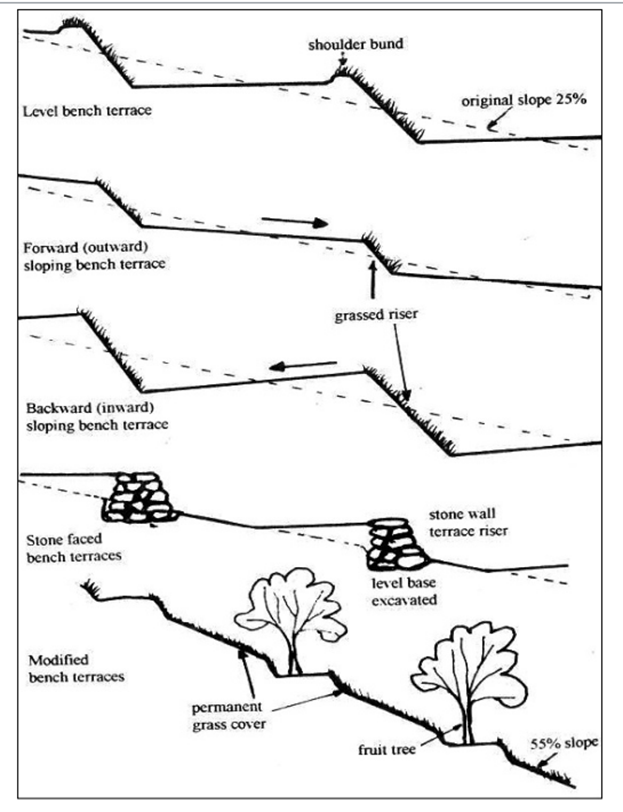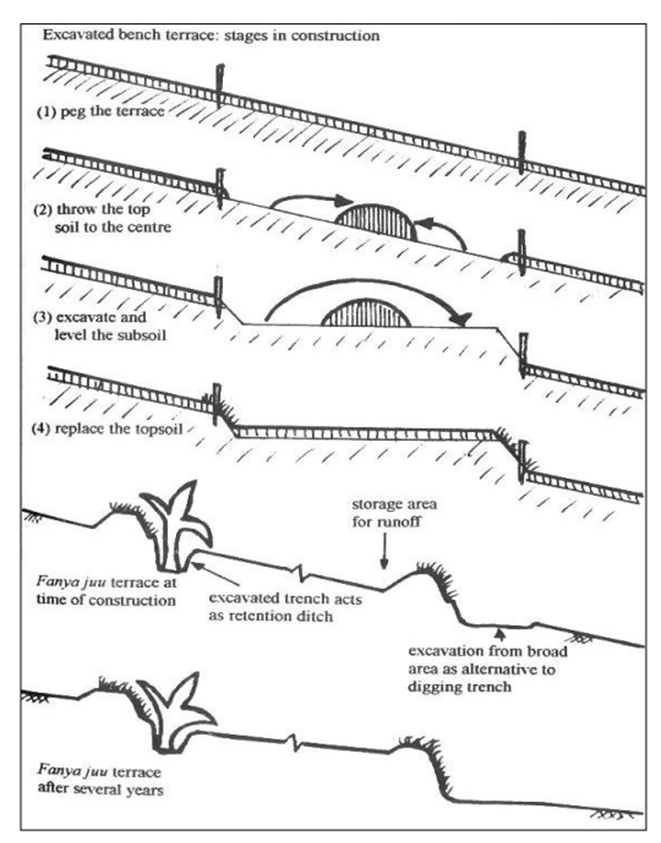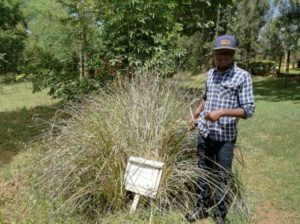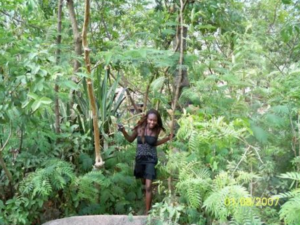Soil and Water Conservation Structures

This post is also available in:
This post is also available in:
![]() Français (French)
Français (French) ![]() Deutsch (German)
Deutsch (German) ![]() हिन्दी (Hindi)
हिन्दी (Hindi) ![]() العربية (Arabic)
العربية (Arabic) ![]() Türkçe (Turkish)
Türkçe (Turkish) ![]() 简体中文 (Chinese (Simplified))
简体中文 (Chinese (Simplified)) ![]() Português (Portuguese (Brazil))
Português (Portuguese (Brazil))
Soil conservation structures protect the soil before seasonal crops establish. They can be constructed directly from the start or develop from lines with protecting contour stripes.
Soil conservation structures range in wider meaning from uncultivated strips over shelterbelts or terraces to costly engineering.
In the broader sense, structures can mean anything permanent or barriers to wind or water flow of soil, wood, stone, or concrete.
Soil and water conservation structures stay in place, so, e.g., terraces can be formed even from belts with permanent vegetation cover. Terraces are most stable if they slope inward or are level (Figure 1). They can consist of a typical soil structure, stone, or concrete or permanent stripes with dead or live plant materials (trash lines or uncultivated contour strips) slowly forming terraces (Figure 2). They can be big or small and made by digging, ploughing, or ridging soil by placing stones, sticks, or plants/seeds in the ground. Plant-covered conservation lines can be established by avoiding tillage of narrow contour strips – with or without seeding protecting plants. Slowly terraces can build up by sediments deposited where water can enter even at the start of the growing season. Structures like fences can also help against water and wind erosion. However, fences of sticks against wind erosion are sometimes cut in an area where they also are needed to protect the soil.
Terraces can also be made quickly as bench terraces with more work invested from the start and with the topsoil on the top. Structures can also include cut-off drains and gully control if needed and made well – these can be small or big projects. See Figure 1 below.
More related figures are also found in the section on plant cover.

Figure 1. Bench terraces
Figure 1. Bench terraces can have many forms. From top to down, either: a) Level and maintained by a permanently vegetation covered ridge (shoulder bund). b) Forward or outward sloping and erosion reduced by grass covered steep slopes are usually not fully effective. c) Backward sloping terraces are usually stable and fully effective. They can even be weeded under tree crop between permanently covered slopes. From Muriuki & Macharia (2011) citing Thomas et al. 1997 based on C G Wenner’s compilations for Kenya.

Figure 2. Construction of bench terraces and Throwing up-hill terrace formed by the erosion of topsoil to the lower part
Figure 2. The four upper drawings: Construction of a bench terraces with the topsoil staying on top. The two lower: Throwing up-hill (fanya juu) terrace formed by erosion of topsoil to the lower part. They can later be remade into bench terraces by digging. From Muriuki & Macharia (2011) citing Thomas et al. 1997 based on C G Wenner’s compilations for Kenya.
Water conservation and water harvesting, e.g., with ferrocement
Water conservation structures like big containers for water from roofs and courtyards, or dams and ponds, can conserve soil and water in liquid forms. It is not in focus in this chapter and, e.g., described for Africa in several books and videos by the very experienced Erik Nissen Petersen, e.g., recommending using experienced specialists in breaking dams because it can be risky. However, these small dams will often be filled with silt, where a protected spring or a pump can be used to take up the water. One of the interesting recommendations is to use light, low-cost ferrocement tanks of good sand (<2 mm, cement, and iron), where good building sand is available. Many binding and barbed wires are used as well as wire mesh. It is completely covered on both sides with a strong cement mortar. Waterproofing is done with a suited concentrated cement. Earlier promoted baskets of sticks and reeds covered like ferrocement were found not to last long.
Water conservation directly in fields (called ‘in situ’) helps water enter the soil within the field and many forms of soil conservation. See also the section focusing on water conservation, including irrigation methods.
Slowing flows can be safer than trying to block them, e.g., for gully control.
Massive structures can concentrate and accelerate wind or water flows passing over or around them via gaps between or weak spots. This can increase erosion by wind or water and is often a neglected problem. It can happen with built structures and even with certain plants like bamboo, sisal, or even compact lines of vetiver grass lines, unlike most smaller and scattered grasses. For vetiver grass, see Figure 3 left. The overflow should be to secured surfaces and undermining prevented. Slowing and filtering the flow is usually safer. Kind terraces or steps can form. Establishing plants in gullies or other highly eroded areas can require a slow-release source of nutrients, nitrogen-fixing bacteria, and beneficial root fungi (e.g., from grassroots to trees without needles). A low-cost approach to gully management worth trying is to lead the water off to a safer, secured route. This consists of a standard guideline. One can also try to dump crop residues, tree branches, scratched tree legume seeds, soil, and roots from where they fixed nitrogen in the top of the gully, so they hopefully settle and stabilize the gully in the areas where the flow is slow. A photo in Mandal (2010) shows how legume tree seeds resulted in the greening of a stony hill (below). Figure 3 right.
Windbreaks: Important in some areas, but too compact types are risky.
Windbreaks or shelterbelts in temperate areas should have about half open to look through, 30-70% visual opening one can look through at the season the effect is most important – usually seeding times. Shelterbelts of deciduous trees (with no leaves in the winter) will give a more even distribution of snow than evergreen conifers.


Figure 3. Vetiver grass conserving a terrace edge at Vi Agroforestry, Kitale in Kenya (left). Stony hill revegetated spontaneously starting with seeds of the nitrogen-fixing tree legume and pioneer plant Calliandra calothyrsus (small leaflets) followed by e.g. Senna spectabilis (bigger leaflets). Photos by Torsten Mandal in Kenya 2019 and 2017.
Concentrating and accelerating winds in openings should be avoided. Windbreaks should have no sudden ends at the sides or where roads pass. Likewise, wind-exposed tree lines need low branches with shrubs or short trees near the ground. With dense hedges and little or no air movements, the soil can get too hot for seeds to germinate in tropical lowlands, as a barefooted farm boy in Sudan mentioned to a team of experts. Soil surfaces hotter than the human body are common in direct sun in the tropic. They can prevent seeds from germinating or emerging in sunny periods (personal observations, Kenya 1994-96). Accordingly, scattered, valuable trees are traditionally used in the Sahel in a parkland agroforestry system. Where heat is not the problem, a gradual reduction of the windbreak’s height can also be used so the wind is not quickly pulled down after hitting it.
Finding the proper slope or the contour line
Slopes in fields are often irregular, and it can be challenging to make structures with a no slope or a constant slight slope of, e.g., 3 % to lead off the water slowly. No slope can be used in some infiltration ditches but see below about landslides. A ditch to direct water away can have a 1-5% slope can work, e.g., along roads (DiBiaso 2000). One can use a straight string with a spirit level at the middle or an A-frame of three joint sticks with a string from the top of the A-shaped structure to a load. Depending on the slope between the less of the A-frame, the string can be at marks at the horizontal stick to show 0 and, e.g., a 3% slope. The slope is not critical for water infiltrating in permanent vegetation or stone cover without raised edges.
If water is led from the field and downslope, it can be led down at broad grazed waterways. However, these often become overgrazed, eroded cattle tracks and gullies on shared land with common pastures at the top of the hill. The water mustn’t be collected at the lower part of drains or furrows and causes concentrated rapid flows. Segmented or tied structures can help and should often be used to prevent sideward flows. Likewise, getting most water to infiltrate between structures can help promote water infiltration by a stable, open, and biologically active soil. In some cases, measuring the slope is unnecessary because the water can infiltrate well.
Landslides, cut-off drains, and infiltration ditches.
A cut-off drain above the conserved fields is usually recommended to prevent uncontrolled flows from higher areas. If such water is collected in a safely constructed pond high on the slope, it is easier to lead down by gravity for irrigation when needed. Water may be conserved if water infiltration ditches are used, but landslides can be a risk in some areas where much entering water can make the topsoil unstable and detached from the subsoil. A subsoil with compact clay can hold back the water, so the soil layer above becomes a thick unstable liquid. It can occur also in areas with little slope. Then heavy trees give extra weight, while low hedges of shrubs may not help much. Soil with a mixture of big and small particles and stable aggregates tends to be more durable. Infiltration ditches can be made safer if they do not cut through the soil in an almost continuous line. Accordingly, water-infiltration-ditches where landslides could start. can be replaced with holes or half-moon structures can be scattered. They can also be on the surface. Instead, scattered water harvesting holes, short ditches or half-moon-shaped structures can be used safer. Short shrubs and scattered pruned, light trees and better than wind-exposed contour lines of tall, heavy trees with shallow roots along contour ditches. Importing widely promoted conservation or zaï-pit farming methods from sandy, semiarid areas in the Sahel to more moist areas, with, e.g., more than 1,000 mm rainfall a year, can cause problems with waterlogging and reduce yields. Also, if the worst soil fertility problems are not solved at the seeding point, farmers may not work much to solve water problems and vice versa. If too fresh compost or manure is used, it can harm roots and seeds – particularly if it is combined with waterlogging and poor aeration due to smelly toxic gases and organic acids. Adaptations can be made like seeding the seeds mainly on the sides of pits.
Terrace formation: Differing strategies, risks, and benefits.
Bulldozers and tractors can form terraces, which can compact the subsoil and cause more erosion. It is also essential to keep the topsoil on top of the subsoil so that seedlings can grow fast, and water and nutrients can be used by roots also after shallow rains.
Terraces can also be formed progressively or passively by water entering contour lines continuously protected by low vegetation, litter, or stones. Seeding or planting grasses, herbs, shrubs, and trees along such lines can help. Hedges of shrubs or low trees can help stabilize roots and organic matter and reduce rain erosivity, unlike trees without low leaves (Luna et al., 2000; Shinohara et al., 2018). They can benefit from nutrients also in topsoil covered by subsoil unless shallow rains only moisten the soil surface. Seeds of wild legumes usually need pre-treatment to germinate in time to survive, and they can need help to emerge in hot soil or compete with other plants when young, e.g., by getting access to compatible nitrogen-fixing bacteria and phosphate. These methods allowed farmers to establish small trees with short intervals like 10 cm that hold back plant litter. These protein-rich litter made a biologically active, porous, and stable soil surface ideal for water infiltration. This was combined with leaves and twigs collected near the surface all the year, good shade feed for biological activity, and little or no need for weeding under established hedges. See Mandal (2010) for improved low-input methods to establish tree legumes as contour hedges, making direct seeding much more reliable.
Lessons learned in Kenya: From bulldozer and orders to more appropriate and participatory methods.
In Kenya, e.g., in Machakos and Kitui districts, promoting bulldozer-made terraces and a colonial approach based on top-down orders were used first. It was partly successfully replaced by informing all levels of other methods. These included promoting terraces formed as progressive or passive terracing by erosion. It can be done first by throwing soil up the slope in big contour ridges from trenches for overflow and establishing a protective cover of grass and small fruit trees or nitrogen-fixing shrubs/trees for fodder, manure, fuel, etc. These are called fanya-juu (making upward) terraces in Swahili. See the Figure 2 lower part, above in the text. Short-term benefits from water conservation are important for motivating farmers. So are reducing initial investments and increasing multipurpose benefits from strips with permanent vegetation.
Methods and experiences from western and eastern Kenya have been described and illustrated by Watene and others (2021) and Muriuki (2011), respectively.
- Challenges of excess water, local adaptation, protective plants, and slope.
Maintenance and leading excess water away safely are challenging, but some erosion control is in place at most sites in Kenya. This was partly driven by demand for fruits and milk products. Development aid also plaid an essential role in introducing appropriate methods and local participation at all levels. Guidelines from hilly clay soils were used all over Kenya but later revised in the sandy and coastal areas where the promoted structures were much bigger than needed. Slope angles should also be fitted to soil types as the least stable soils are sandy soils and soils with a uniform texture and few roots. Maintaining soil fertility and plant cover is challenging in eroded areas, despite some nutrients being deposited with erosion. Legumes covering the ground, e.g., with grass, may only live a few years for the same species of herbs, but a rotation can be used. Recycling nutrients from stables (and toilets) to terraces is challenging, particularly if nitrogen fixation is ineffective: if rainwater is mixed with livestock dung and urine, much fodder is removed from them, or erosion is not fully stopped. Recycling humane waste is also challenging, but most nutrients are at least found in the urine, and multipurpose hedges and ash could be used too for recycling.
Outward sloping terraces can be stabilized by making them slope inward, but topsoil should stay on top, and run-off water still be managed if it cannot always infiltrate safely.
- Bench terraces: Investing more in getting topsoil on top and inward slope
Bench terraces require more initial work but can hold the topsoil and make the slope have an inward direction. Terraces formed by erosion can also be changed afterward. To create bench terraces:
1st contour lines are marked out,
2nd topsoil is placed in the middle,
3rd subsoil from the upper part is moved to the lower,
4th topsoil is placed on top,
5th protective vegetation is established. See the detailed section on soil conservation structures. See the Figures 1 and the upper part of 2 above.
- Adaption of dimensions to local conditions
Each country, e.g., in East Africa, tends to have different guidelines that tend to depend more on political borders than the landscape and farmers. Several factors are essential for soil conservation needs (rainfall intensity, length and steepness of slope, soils, crop factors, and conservation methods). Smaller structures can be suitable if distances are smaller and can be combined with mechanization needs. Big vertical distances of, e.g., 1.7 meters (a common eye height), can expose much subsoil on the upper part if good conservation strategies are not used within the terrace. Such a guideline was introduced in Uganda in colonial times, as the smallest officer guest farmers could be convinced. Others recommend shorter intervals (see, e.g., Muriuki & Macharia (2011, chapter 4, for gentle slopes). Local experience and availability of time, land, and material may be a more relevant guide. Adaptations to sandy coastal soils were introduced late in Kenya. In Asia, traditional rice field terraces are often only about knee-high but steep. The most important is, that structures will be maintained and do not concentrate water breaking through. In some eroded areas, stones must be removed from fields and placed along contour lines within a short distance as practical for fieldwork. Particularly shallow soils will be lost at the upper part of terraces if the distance is big. It is important to start from the upper part of the slope and combine it with other measures. Very intense rainfall incidences are the most important for erosion, so if structures are used, they should help and not harm in these extreme events. Resilient soil conservation is particularly important in seasons with low plant cover near the surface, making structures important and challenging.
Very narrow permanently vegetated stripes can help form terrace structures if their interval is sufficiently short and if they slow rather than blocking the water flow. However, even for hardy species like vetiver grasses, their nutrient supply, multipurpose use, and establishment cost are essential. Nutrient cycling and nitrogen fixation should be included – particularly if nutrients are removed for fodder.
References
Baumhardt RL, and Blanco-Canqui H 2014 Soil: Conservation Practices. In: Neal Van Alfen, editor-in-chief. Encyclopedia of Agriculture and Food Systems 5, Elsevier, 153-165.
DiBaso, M 2000 Ditch Basics. Road Business 15, 4-5. https://t2.unh.edu/sites/t2.unh.edu/files/documents/newsletters/2000/DitchBasics.pdf
Hudson W N 1987 Soil and water conservation in semi-arid areas. Silsoe Associates Ampthill, Bedford United Kingdom. Soil Resources, Management and Conservation Service. FAO Land and Water Development Division. Food and Agriculture Organization of the United Nations Rome, 1987 https://www.fao.org/3/t0321e/t0321e00.htm
Land and Water Division 2000 Manual on Integrated Soil Management and Conservation Practices. FAO land and water bulletin Series number: 1024-6703. 214 pp. ISBN: 9251044171 https://www.fao.org/publications/card/en/c/31f117c4-13e2-5631-bf16-ebaaa10b714f
Luna et al. 2000. The role of olive trees in rainfall erosivity and runoff and sediment yield in the soil beneath. Hydrology and Earth Sciences 4, 141-153. https://hess.copernicus.org/articles/4/141/2000/hess-4-141-2000.pdf
Muriuki JP, Macharia PN 2011 Green Water Credits Report K12: Inventory and Analysis of Existing Soil and Water Conservation Practices in Upper Tana, Kenya. https://www.isric.org/documents/document-type/green-water-credits-report-k12-inventory-and-analysis-existing-soil-and Open access.
Mandal T. 2010. Low-cost soil and water conservation with many early benefits. Presentation Researchers’ Day: Climate Change Impact, Adaptation and Mitigation GEUS, Inst. of Geography, University of Copenhagen. 7 October 2010. Arranged by the Climate Change Task Force. https://www.yumpu.com/en/document/view/35209735/present-danish-water-forum
Thomas DB et al. 1997. Soil and water conservation manual. Soil and Water Conservation Branch, Min. Agric. Livestock Dev. and Marketing, Nairobi Kenya.
Watene G and others 2021 Water Erosion Risk Assessment in the Kenya Great Rift Valley Region Sustainability 2021, 13(2), 844; https://doi.org/10.3390/su13020844
Yoshinori et al. 2018 Factors influencing the erosivity indices of raindrops in Japanese cypress plantations. Catena 171, 54-61, December 2018, DOI:10.1016/j.catena.2018.06.030 http://www.ffpri.affrc.go.jp/ffpri/en/research/results/2018/20180910-06.html









































































